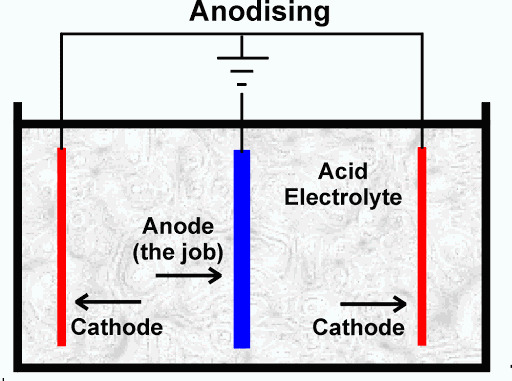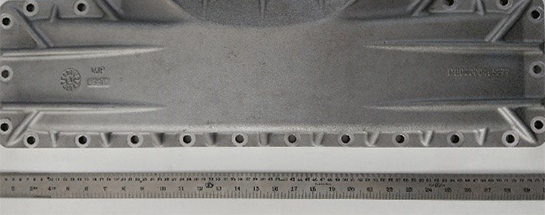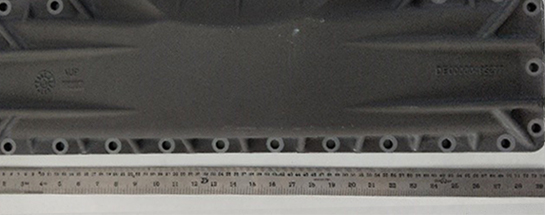
Hard Anodizing in Aluminium Casting
Jargons of Anodizing
Before we get into the description, it is better to know the jargon of the process
- Anodize - Creating a hard oxide layer on the surface of aluminium parts via an electrolytic process
- Electrolyte - An electrolyte is a substance that produces an electrically conducting solution when dissolved in a polar solvent such as water. The dissolved electrolyte separates into cations and anions, which disperse uniformly through the solvent.
- Anode - An anode is an electrode through which the conventional current enters into a polarized electrical device
Anodize
Aluminium has strong affinity to oxygen and formation of a compact oxide layer onto its surface that exhibits high corrosion resistance in air and water solutions.
The anodizing is an electrolytic process, the aluminium casting immersed in the electrolyte (usually acids e.g. sulphuric, ortho phosphoric and oxalic) is the anode. The cathode is made of aluminium alloy, lead or stainless steel.
The thickness of the coating is mostly influenced by the electrical charge passed through the metal/solution interface, temperature, and chemical composition of the electrolyte. The last two factors determine the kinetics of dissolution of aluminium oxide. Thus, the coating is composed of two layers. The inner layer (called the barrier layer) is compact, but usually thin (tens to hundreds of nm). The outer layer may be thick and porous

Anodizing is the method which is often applied to improve the corrosion resistance of aluminium alloys. Moreover, anodic coatings improve the
- Adhesion of paints
- May be easily coloured (aesthetics)
- Wear resistance
Types of Anodizing
The different types of anodizing are
- Chromic Acid Anodizing
- Sulphuric Acid Anodizing
Chromic Acid Anodizing
Chromic acid anodizing is an electrolytic process using electricity (DC current) and a Chromic acid electrolytic solution causing oxidation of the aluminium surface to form a thin dense flexible grey “harder” film of aluminium oxide under controlled conditions.
Sulphuric Acid Anodizing
Sulphuric acid anodizing is an electrochemical process that creates a thin aluminium oxide film by rapidly controlling the oxidation of an aluminium surface. The electrolyte used is sulphuric acid
Hard Anodic Coatings on Aluminium Alloys:
Hard Anodizing is ultimately is the thickest form of anodizing (Above 20 microns), creating an oxide layer which is between 20-100 microns thick, depending on the base alloy being treated. It offers the highest increases in hardness, wear resistance and electrical resistance and is primarily a functional coating. It is also performed in a sulphuric acid solution, but with higher acid concentration, low temperature and a higher voltage applied.
Properties of Hard Anodic Coatings
The properties of hard anodic coatings are strongly dependent on the chemical composition of the alloy and the anodizing process itself.
Abrasion resistance of the anodic coating depends also on its hardness and friction coefficient. Hard anodizing on normal extruded aluminium will retain the same colour whereas when done in aluminium alloy will have a grey colour. Some of the advantages of hard anodic coatings are
- Corrosion resistance
- Erosion resistance
- Impingement resistance
- Abrasion resistant
- Wear resistant
Application of Hard Anodic Coatings
Depending on the desired properties of the coating they are applied in the different fields. Some of the applications of Hard anodizing are used in the following industries
- Marine
- Aviation & Aerospace
- Food Processing
- Sporting Goods
- Building & Architecture
Due to relatively good corrosion resistance, hard anodized aluminium elements are applied in the marine environment (e.g. Propulsion systems, Torpedoes, Waterjet Systems, etc.,)
At VJP
We use aluminium alloy A356 material for supplying Marine Engineering Machined Castings with in-house facility of casting, heat treatment, machining, and hard anodizing to some of the leading European manufacturers of propulsion systems and Waterjet systems. The typical example of anodizing done in one of our 30” length ¬casting is as shown below
Before Anodizing

After Anodizing

Inspection
No two pieces of anodised metal look exactly alike. Slight colour variations are due to differences in alloy composition; the grain size and grain orientation developed during the heat treatment.
Main idea is to check the thickness of the coating which ensures the longevity of the surface when exposed to extreme conditions.
Sample of inspection report shown below in the Fig.1.

